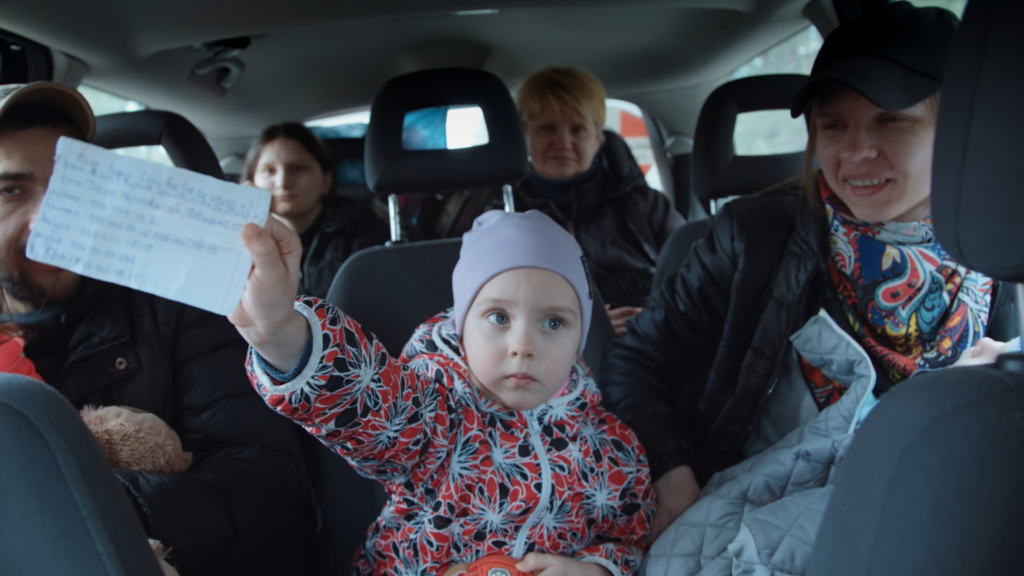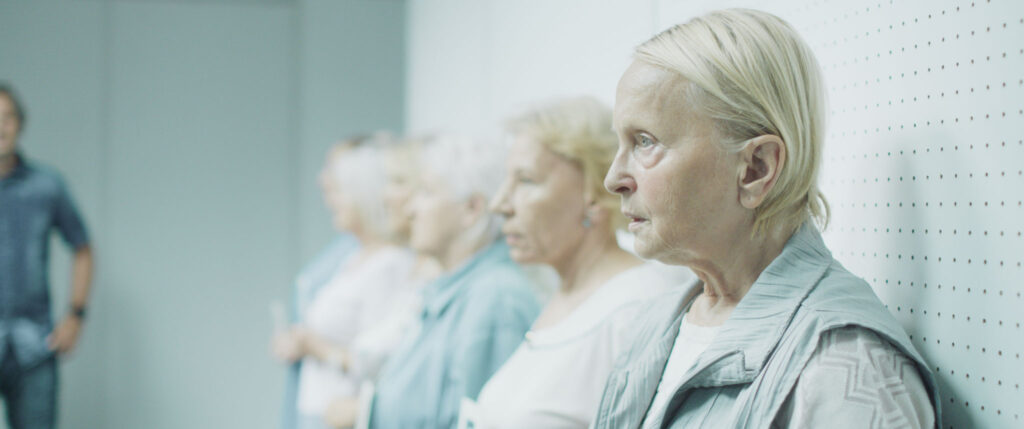September 14, 2023
by Carla Hay

Directed by Maciek Hamela
Ukrainian and Polish with subtitles
Culture Representation: Taking place in Ukraine and in Poland in early 2022, the documentary film “In the Rearview” features a nearly all-white group of people (with one black person) who were affected by the Russian invasion war of Ukraine.
Culture Clash: “In the Rearview” director Maciek Hamela, who is from Poland, documented the van rides that he gave to refugees escaping from Ukraine to Poland.
Culture Audience: “In the Rearview” will appeal mainly to people who are interested in watching a documentary about what it was like to evacuate from Ukraine during the Russian invasion that began in 2022.

The compelling documentary “In the Rearview” offers a glimpse into what some Ukrainian refugees were experiencing during the Russian invasion in 2022, while riding in a rescue van crossing the border into Poland. The film is intimate and sometimes very raw. It’s filmed in cinéma vérité style, in every sense of the word: There are no interviews, no re-enactments and no follow-ups to see what happened to the people in the documentary. “In the Rearview” had its world premiere at the 2023 Cannes Film Festival and its North American premiere at the Toronto International Film Festival.
“In the Rearview” is the feature-film directorial debut of Maciek Hamela, a Polish citizen who volunteered to drive a van of Ukrainian refugees from Ukraine to Poland when the Russian invasion began in February 2022. About a month after Hamela began doing these rescue missions, he started filming these trips at the end of March 2022. Most of the documentary’s footage shows the passengers inside the van, with the camera facing the passengers. Hamela has said in interviews that all filming was done by human camera operators—not a fixed or hidden camera on a dashboard (also known as a dash cam)—so that the participants knew that they were being filmed at the time.
There are several documentaries that chronicle the horrors of war. In the case of the Russian-Ukrainian war, documentaries about this war tend to focus on the people who are stuck or left behind in the war zone, or the documentaries have discussions of the politics that led to this war. “In the Rearview” has a unique perspective, because it’s about the transition period when war refugees know that they are leaving for a safer place, but there’s still a lot of anxiety and fear of what’s ahead.
It goes without saying that the refugees have had to leave almost all of their possessions behind in their abandoned homes. What causes much more agony is that many of the refugees have been involuntarily separated from loved ones or know that their loved ones have died. The people who have been separated from their loved ones often don’t know where their loved ones are. And if they do know where their loved ones are, communication sometimes isn’t possible for long stretches of time, because the war-torn areas often have no electricity or Internet service. Adding to the pain is the fact that some of the refugees need medical help that they won’t be able to get until they’re safely out of Ukraine.
All of these issues weigh heavily on the refugee passengers who are featured in the documentary. They are not identified by name while they are shown in the van. However, the names of the participants are listed in the end credits of “In the Rearview.” Hamela can be heard and briefly seen during these trips, as he has conversations with the people who are temporarily in his care during this terrible time in the refugees’ lives. Unlike some documentarians, Hamela doesn’t want to make himself the center of the attention during filming. He comes across as compassionate, humble and someone who deeply cares about the safety of these refugees.
Many of the passengers who are in the documentary are groups of families. A few of the refugees are traveling alone. Many are deep in thought and don’t say anything. They look like they’re too much in shock to speak. Some of the refugees are talkative, as if they want to unload some of the burdens they’re feeling.
People of many different generations are featured. The children under the age of 8 are often too young to fully understand what’s happening, but they know something is very wrong. In one of the documentary’s segments, a family with three generations of people, including two married grandparents, are in the van. The grandmother says, “We only left because of the kids.” She later gets teary-eyed when she talks about the family’s 9-year-old cow named Beauty that the family had to leave behind.
Another family has brought the family’s 5-month-old cat (a male with black and white fur), and is shown keeping the cat safe by having it tucked into a basket during the evacuation. The wife in the family says she no longer dreams when she sleeps. She says it’s because at night, she is constantly hearing explosions.
During another ride, a woman in her late 20s or early 30s is a pregnant surrogate, who wonders aloud what will happen after she gives birth. The woman who was supposed to raise this unborn child is apparently missing and is possibly dead. The pregnant surrogate, who is accompanied by her own mother during this van ride, seems to want to take her mind off of this dire situation by talking about her goal to one day open a bakery/sweets shop where people can test the pastries before eating.
The hellish experiences of the war are discussed in a few of the conversations. A girl who’s about 13 or 14 years old talks about witnessing a rape that happened as a direct result of the war. During another van ride, a woman in her 30s talks about how her father’s fingers had to be amputated because of injuries he got while trying to rescue her mother.
In a family of five people, identified in the end credits as having the surname Lichko, the family’s stressed-out patriarch Kirill Lichko describes how his house was bombed while his family members were inside. “I don’t know how they survived,” he says of his family members, with a mixture of relief and apprehension. Kirill has a 5-year-old daughter named Sofia Lichko, who is intelligent and polite. The members of this family were able to escape with their identification, so Sofia demonstrates how she was taught to show her ID form if she’s asked to show her ID.
The van is also a makeshift ambulance that doesn’t have medical supplies but is able to accommodate people who are not able to sit up. One of the more memorable refugees in the documentary is an injured college student, who is originally from the Democratic Republic of Congo. She is traveling alone and has injuries that require medical attention, so she is seen lying down in pain as she tells her story.
The Congolese immigrant says she came to Ukraine to study the oil industry and has been living in the Ukrainian capital of Kyiv for the past 10 years. She has a sister who lives in Ternopil, Ukraine, because her sister came to Ukraine to study economics. This Congolese immigrant says the oil industry doesn’t interest her.
She also mentions that during her time in Ukraine, she opened a shop that sold African imports, but the business failed. Despite all of the uncertainty over her future, she is certain that she will come back to live in Ukraine, which she says is like a second homeland for her. She says she will return to Ukraine “when things calm down.”
These rescue trips across the border are also fraught with tension when the van is stopped by soldiers at the border. The documentary doesn’t show anyone being turned away, but you get the feeling that Hamela would’ve just found another way to get the refugees across the border. The evacuations filmed in this documentary happened early enough in the war for the refugees to be let across the border much easier than if they tried to evacuate when things got worse during the war.
“In the Rearview” is very much a no-frills “snapshot” documentary, where viewers are just given glimspses into the lives of the people who are featured. There are a few questions that remain unanswered, such as: “How did Hamela deal with a shortage of gas fuel in the Ukraine?” “Where did he drop off people who had nowhere to go?” “How far was he willing to go to drive people to help them find their missing loved ones?” Although “In the Rearview” does not answer these questions, viewers will have a clear sense of the vulnerable emotions of these refugees who were filmed during a very tumultuous and dangerous time in their lives.








